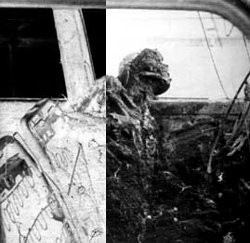|
Related : The Gulf War Reconsidered, NYRB : Gulf War Stories the Media Loved — Except They Aren't True, FAIR : The Lies We Are Told About Iraq, LAT : How PR Sold the War in the Persian Gulf by John Stauber and Sheldon Rampton : George Bush Sr. Armed Saddam, CJR : Bush Orders Millions of Documents to be Kept Secret, AP : Bush Sr.'s Waiver of Conflict of Interest, Congressional Record Ambassador April Glaspie's Meeting With Saddam on July 25, 1990 Glaspie: I know you need funds. We understand that and our opinion is that you should have the opportunity to rebuild your country. But we have no opinion on the Arab-Arab conflicts, like your border disagreement with Kuwait I was in the American Embassy in Kuwait during the late 60's. The instruction we had during this period was that we should express no opinion on this issue and that the issue is not associated with America. James Baker has directed our official spokesmen to emphasize this instruction. The Results of the First Gulf War : DOD Persian Gulf War Statistics : The Gulf War: Secret History, Stars and Stripes : The Gulf War: Not so Clean, The Bulletin of Atomic Scientists : How the US Intentionally Destroyed Iraq's Water Supply, Progressive : The Unseen Gulf War, photos by Peter Turnley : This Is War, photos from The Memory Hole |
LIES | THRIVES | ACT | CONTACT ..:: Pentagon lied that Iraqi forces stood at Saudi border Before launching the Gulf War, Bush Sr. claimed that an Iraqi juggernaut was threatening to roll into Saudi Arabia. Citing top-secret satellite images, Pentagon officials estimated in mid–September that up to 250,000 Iraqi troops and 1,500 tanks stood on the border, threatening the key US oil supplier. The St. Petersburg Times acquired two commercial Soviet satellite images of the same area, taken at the same time, and found no Iraqi troops were visible near the Saudi border — just empty desert. After the war, Gen. Colin Powell admitted that there had been no massive build up. A US senior commander told Newsday after the war, "There was a great disinformation campaign surrounding this war." ..:: False testimony about Iraqi atrocities Before the motion for war, members of Congress were presented with the tearful testimony of a 15-year-old Kuwaiti girl, known only as Nayirah. She described how, as a volunteer in a Kuwait maternity ward, she had seen Iraqi troops storm her hospital, steal the incubators, and leave 312 babies "on the cold floor to die." Seven US Senators later referred to the story during debate; the motion for war passed by just five votes. In the weeks after Nayirah spoke, President Bush senior invoked the incident five times, saying that such "ghastly atrocities" were like "Hitler revisited." Nayirah was actually the daughter of the Kuwaiti ambassador to Washington and had no connection to the Kuwait hospital. She had been coached — along with the handful of others who would "corroborate" the story — by senior executives of Hill and Knowlton in Washington, which had a contract worth more than $10 million with the Kuwaitis to make the case for war. ..:: Pentagon lied about strength of Iraqi troops After the war, the House Armed Services Committee issued a report on lessons learned from the Persian Gulf War. It concluded that at the start of the ground war in February, the US faced only 183,000 Iraqi troops, less than half the Pentagon estimate. ..:: CIA forged documents were presented to the UN Security Council In Saddam's Bombmaker, scientist Khidhir Hamza describes a bogus story planted by the CIA in the Sunday Times on 2 April 1995. The story reported that Hamza had confirmed a secret Iraqi weapon programme, and claimed that he had been kidnapped in Greece and probably assassinated. The CIA had planted the story and documents in order to smoke him out, and it worked. Hamza contacted the US Embassy in Budapest was brought to the US. A week later, Madeline Albright quoted the CIA-forged documents at the UN Security Council in order to prevent any relaxation of the regime of sanctions on Iraq. ..:: FBI planted capacitors found at Heathrow in 1990 The capacitors destined for Iraq found at Heathrow in 1990 turned out to have been planted by the FBI. ..:: Reagan admin covered up war against Iran A June, 1990 Nightline episode revealed a massive cover-up of the USS Vincennes' whereabouts and actions when it shot down an Iranian airliner in 1987, killing over 200 civilians. The cover-up was designed to hide the US secret war against Iran, in which, among other actions, US Special Operations troops and Navy SEALS sunk half of Iran's navy while giving battle plans and logistical information to Iraqi ground forces in a coordinated offensive. Koppel said, "It is becoming increasingly clear that George Bush [Sr.], operating largely behind the scenes throughout the 1980s, initiated and supported much of the financing, intelligence, and military help that built Saddam's Iraq into the aggressive power that the United States ultimately had to destroy." |





